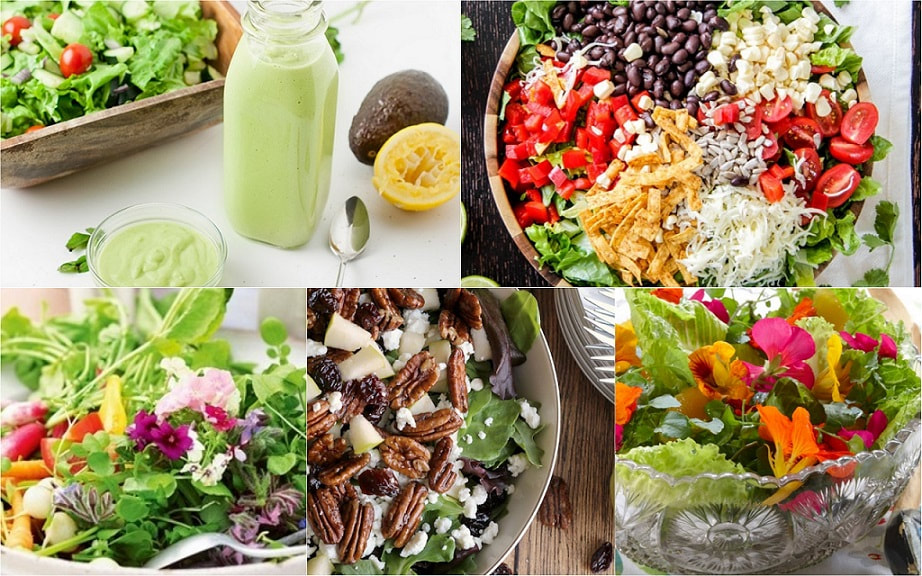|
Is it often that you top your healthy salad with croutons, bacon and cheese? The toppings that you choose decide on the health quotient of your salad. Given here are the scoop on five unexpected toppings that will boost the flavor and make the salad healthier.
Florets in your Salads Have you ever imagined of adding flowers to your salad? Why not try it out when the salad has greens, veggies and even fruits. Edible flowers like marigold, violets, roses and pansies have eye-catchy color and flavor in them, which are essential for your salad. But be sure to use flowers that are labeled as edible as many blooms are grown using dangerous pesticides or some blooms may be toxic. For further details on edible blooms and their use in salads, please visit the website www.firsteatright.com. Registered dietitian nutritionists reason out that phytonutrients give flowers their beautiful colors. Though eating flowers does not assure better health to a person, the main purpose of adding blooms to the salad is just for the eye-catchy effect of the salad. It is generally proved that food that looks appetizing and tastes great provides an individual with more meal satisfaction. Go Green with Butter Fruit The debates over avocado (butter fruit) are never ending. Avocados are high on fats where most of it is heart-healthy monounsaturated fat. These fruits contain the hard-to-get vitamin E and are abundant in fiber where consuming a quarter portion of the fruit supplies the body with around 3.5 grams of fiber. (The Dietary Reference Intakes (DRI) for fiber is 25 grams for women and 38 for men). These healthy fats from avocado are helpful in yet another way: carotenoids, a type of antioxidant present in many salad veggies like carrots or spinach, are better absorbed in people who consume this fruit. There’s more to Herbs than Flavor Herbs are generally used for added flavor with nutritional nothings. But research proves that herbs contain more phytonutrients than typical salad veggies with the ability to lower blood pressure and control blood cholesterol levels. RDNs suggest adding both fresh and dried herbs like parsley, garlic, oregano, basil, chives, rosemary, chives, thymes and others for a great taste. Herbs are simple to use: sprinkle them on your salad or add them to a vinaigrette made using olive oil. Dress It Up Full-fat salad dressings are generally avoided. Studies reveal that oil in salad dressings aids in absorbing the carotenoids in the salads, like avocados. Fats in avocados or salad dressings are useful to absorb the fat-soluble vitamins A, D, E and K. Finally, one or two tablespoons of fat can help us feel full and more satisfied. Go Different Most of us have used berries, apples, oranges and pears in our salads. We have even added dried cherries, dried apricots or raisins to our greens. But the latest trend is to splurge on non-traditional fruits like watermelon, pomegranate seeds, nectarines or peaches, which are packed with vitamins, phytonutrients and fiber. You can also try the non-dried versions of dried favorites — fresh cherries, grapes and apricots which are lower in calories than their dried counterparts. Here is a Simple Recipe of an Avocado Dressing Ingredients 1 avocado ¾ cup water 2 tablespoons apple cider vinegar 1 clove garlic ¼ teaspoon dried dill 2 tablespoons finely chopped fresh chives Salt and pepper to taste Directions
Serving size: 2 tablespoons Serves 8 Calories: 45; Total fat: 3.5g; Saturated fat 0.5g; Cholesterol: 0; Sodium: 80mg; Carbohydrates: 3g; Fiber: 2g; Sugars: 0; Protein: 1g
0 Comments
Leave a Reply. |
AVOID FRAUD. EAT SMART.+91 7846 800 800
AuthorDietitian & Nutritionist Dr. Nafeesa Imteyaz. Archives
November 2022
Categories
All
Dr. Nafeesa's Blog @blogspot |
- Home
- Written Testimonials
- Consult
- Clinics
- Blogs
-
Diet & Nutrition
- Diabetes Reversal
- IVF IUI not needed for PCOS PCOD Infertility
-
Medical Nutrition
>
-
Disease & Conditions
>
- Infertility | PCOS
- Diabetes Mellitus
- Cholesterol
- Hypothyroid
- Kidney Problems
- Hypertension
- Cardiovascular Diseases
- Liver Diseases
- Gastro intestinal disorder
- Cancer
- Metabolic Disorders
- Orthopedic Disorders
- Eating Disorders
- Dietary Recall
- Weight Record Filled By Clients
- Online Payment Transaction Details
- Online Clients Weight Check Form
- Our Program Package Service Charges
- Weight Record 2017 Clients
- Measurements sent by Clients
- Terms & Conditions Of Payment
- Thanks. Your Form is Submitted
- Video Testimonials
- Lifestyle & Wellness
- Lifestyle & Wellness Blog
- Allergy & Intolerance
- Weight Loss / Gain
- Weight Loss / Slimming Blog
-
Disease & Conditions
>
- Life Cycle Nutrition >
- Sports Nutrition >
- Integrity in Nutrition
- Knowledge Centre
© COPYRIGHT 2022. ALL RIGHTS RESERVED. FRST HEALTHCARE PVT LTD.
Dr. Nafeesa Imteyaz of First Eat Right clinic, is the Best Dietitian Nutritionist in Bangalore. Best Dietitian Nutritionist in Pune. Best Dietitian Nutritionist in Hyderabad. Best Dietitian Nutritionist in Chennai. Best Dietitian Nutritionist in Mumbai. Best Dietitian Nutritionist in Delhi. Best Dietitian Nutritionist in Kolkata.


